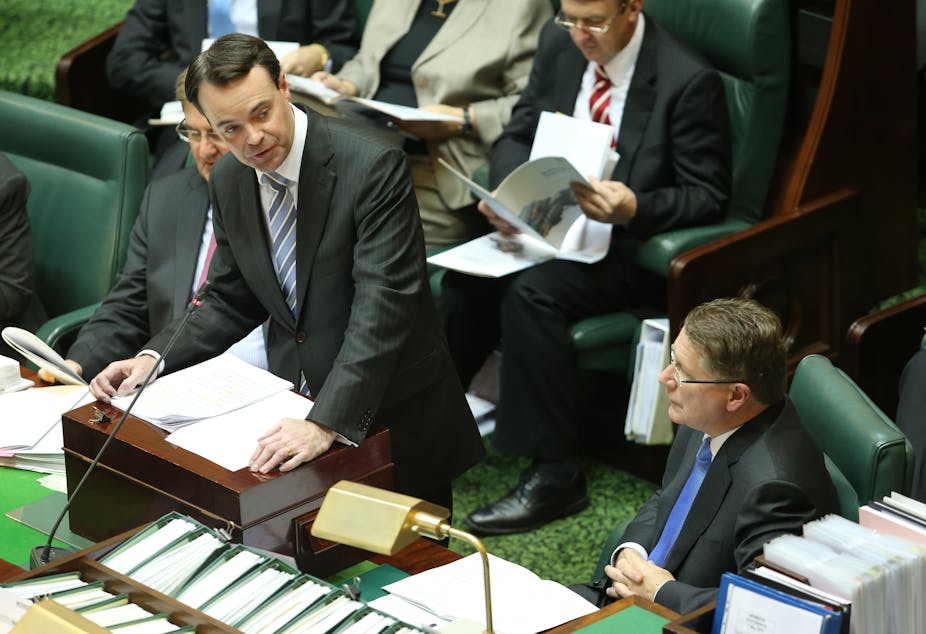The Napthine government kicked up the political tempo in Victoria yesterday, courtesy of the latest state budget. Delivered confidently by the new Treasurer, Michael O’Brien, the budget has let loose a massive wave of infrastructure spending. With the government up until recently languishing in the polls, will it do enough to earn a second term?
Amidst a $6.6 billion sea of trains, new stations, level crossings, schools, community centres, hospitals and almost every type of government building imaginable, sits the centrepiece of the budget: the East West road link designed to connect Melbourne’s Eastern Freeway with CityLink, the state’s original toll road, commissioned by the last coalition government back in 1996.
Costing $6 to 8 billion when complete, this will be a massive investment by any standards, earning high praise indeed from none other than the Royal Automobile Club of Victoria, as well as construction firms keen to be part of the action.
Table 1: Victorian 2013/14 budget in a snapshot ($m)

How much of this sum will be paid for by the state is not clear because a big chunk is to come from private pockets participating in a public private partnership arrangement. Given the spectacular failures of private toll ways in Sydney and Brisbane, and the dismal financial returns from Melbourne’s second toll road, there’s good reason for wondering how much of an inducement will be needed to entice the private sector to come to the party.
A big talking point at the budget lockup was that much was being set aside for a whopping new road while the federal government’s independent infrastructure advisor, Infrastructure Australia, recommended a new train tunnel as a far better transport option, using figures supplied by the state to reach that conclusion — and by a considerable margin.
Buildings apart, there’s not a lot in the budget for education, community services, health and the environment. New initiatives amount to only $132 million, once you adjust for savings and re-priortisations of existing money. In real terms, and last year’s very austere budget apart, this is the least money for new initiatives since the Kennett years back in the 1990s.
In a tough budget for services, health did the best. There’s $100 million more for an elective surgery blitz and another $176 million to treat more patients in high need areas, all designed to get waiting lists down and happiness up with the state’s stretched hospitals, although remember some of this is funded by cuts elsewhere or contingency funding that was already on the table.
There were two main tax announcements. The first almost doubles the revenue from the CBD parking levy, while the second replaces a state revenue-neutral fire levy on insurance premiums with a much lower one levied on everybody instead.
The public service, which has already copped quite a hammering, is being required to cough up $40 million more savings. It’s not clear how this will be sustained, given that 4,600 positions have already been chopped in an 18-month austerity frenzy.
O’Brien’s message was strongly focused on the new asset initiatives, but in the context of a government that had managed its finances well enough to afford them. Contrasting his budget with that of all the other states except resource rich Western Australia, O’Brien pointed to a budget that was in growing operating surplus, and which offered the promise of debt reductions rather than increases into the future.
Debt management was a theme O’Brien was clearly proud about. This sat strangely next to the budget numbers, showing net debt to be on the rise, increasing from $19.8 billion this year to hit $25.1 billion in two years’ time, up from the $11 billion bequeathed by Labor in 2010.
Still, the irony of decrying debt in a budget that embraced it aside, this was a clever budget that will do the job of giving the Coalition the feel of a “do something” administration, after two years under a different Treasurer and Premier who seemed unable to make a decision, or to sell one once it had been made.
More than anything else, this budget is about rebranding the Coalition from a “do nothing” and dithering administration to one that gets things done. The unanswered question is whether it will do enough to earn the Coalition another term. But that’s not about spin, but services on the ground. The next election is due in 18 short months, and most of the announcements in yesterday’s budget will not kick in until just before or after the election contest gets under way.
The East West Link won’t get started until late 2014, and many of the new trains, stations and level crossings not to mention new hospitals won’t start operating till next financial year and after. The budget will be awash with cash at about that same time, with the operating surplus tipped to click $2 billion by 2015/16.
The biggest risk in today’s budget for the Coalition is that it gets things cracking, but just in time for a new government of a different political persuasion to reclaim office, with a balance sheet in a remarkably strong position and an infrastructure program that’s just about to hit full stride.

